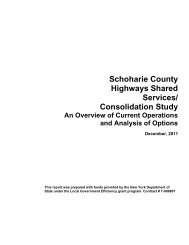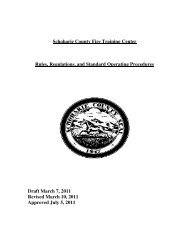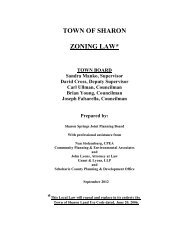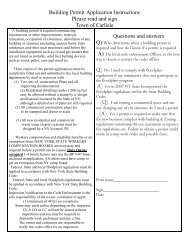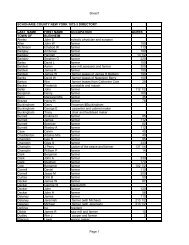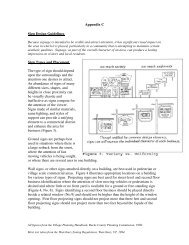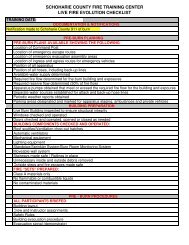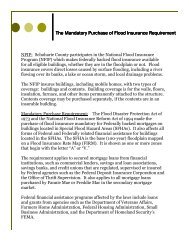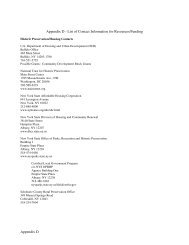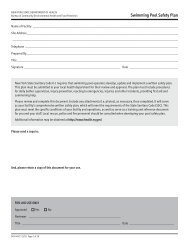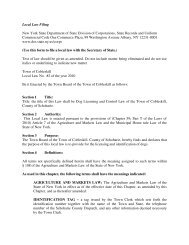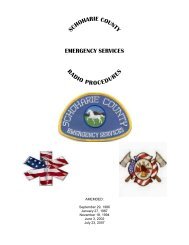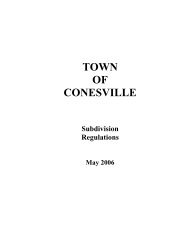What to Do Before, During and After a Flood - New York State ...
What to Do Before, During and After a Flood - New York State ...
What to Do Before, During and After a Flood - New York State ...
You also want an ePaper? Increase the reach of your titles
YUMPU automatically turns print PDFs into web optimized ePapers that Google loves.
GARBAGE• S<strong>to</strong>re in watertight,rodent <strong>and</strong> insectproofcontainers withtightfitting covers.• Use plastic liners.• Pile in a convenientlocation but not nearyour well.HYGIENE• Wash h<strong>and</strong>s with soap <strong>and</strong>water that has been disinfectedor boiled <strong>and</strong> cooled.• <strong>Do</strong>n’t use flush <strong>to</strong>ilets attached<strong>to</strong> a septic tank that is coveredwith floodwaters.MOLDMold growth can become a problem if wetmaterials are not thoroughly dried or discardedquickly. Mold can be a trigger for people withallergies or asthma. For information about mold<strong>and</strong> how <strong>to</strong> clean it up, visit www.health.ny.gov/environmental/indoors/air/docs/mold.pdfMore Information<strong>Flood</strong>ingwww.health.ny.gov/environmental/emergency/flood/docs/flooding_info.pdfInformation on <strong>What</strong> <strong>to</strong> <strong>Do</strong> <strong>After</strong> a <strong>Flood</strong>www.health.ny.gov/environmental/emergency/flood/flood_advice.htmWhen There’s a <strong>Flood</strong>, <strong>What</strong> You Need <strong>to</strong>Know <strong>to</strong> Protect Your Health <strong>and</strong> Safetywww.health.ny.gov/environmental/emergency/flood/docs/when_theres_a_flood.pdf<strong>Flood</strong> Waters Pose Health Riskswww.health.ny.gov/environmental/emergency/flood/docs/flood_risks.pdfResidential Oil Spills <strong>and</strong> <strong>Flood</strong>ing:<strong>What</strong> Homeowners Need <strong>to</strong> Knowwww.health.ny.gov/environmental/indoors/air/docs/oil_spill_flood.pdf<strong>Flood</strong> Recovery: Res<strong>to</strong>ring Water Wellswww.health.ny.gov/environmental/water/drinking/flooding/docs/private_wells.pdf<strong>Flood</strong> Recovery: Sampling Private Wellswww.health.ny.gov/environmental/water/drinking/flooding/private_well_sampling.htmHealth Checklist for Repairing Your <strong>Flood</strong>ed Homewww.health.ny.gov/environmental/indoors/air/docs/flood_checklist.pdf<strong>Flood</strong>ing Fatal Injury Factswww.health.ny.gov/environmental/investigations/face/facts/flooding.htmRepairing Your <strong>Flood</strong>ed Homewww.redcross.org/wwwfiles/<strong>Do</strong>cuments/pdf/Preparedness/file_cont333_lang0_150.pdfCall your local health department or<strong>New</strong> <strong>York</strong> <strong>State</strong> Department of Health5184027530 or 8004581158Follow us on:health.ny.govfacebook.com/NYSDOHtwitter.com/HealthNYGovyoutube.com/NYSDOH<strong>Flood</strong>ingQuickReferenceGuide<strong>What</strong> <strong>to</strong> dobefore, during,<strong>and</strong> after a flood<strong>State</strong> of <strong>New</strong> <strong>York</strong>Department of Health2708 9/11Drinking Food HouseholdWaterCleanup
The Dangers of <strong>Flood</strong>ing• Moving flood waters• Pooling flood waters• Contaminated water <strong>and</strong> food supplyThis brochure highlights important health <strong>and</strong>safety concerns <strong>to</strong> address before, during, <strong>and</strong>after major flooding. It is not intended <strong>to</strong> coverevery type of flooding situation. More detailedguidance is available from the resources listedon the back <strong>and</strong> in “<strong>Do</strong>n’t Be Left in the Dark”at www.health.ny.gov/publications/7064.pdf<strong>Before</strong>• Move important papers, electronics, <strong>and</strong> easilymoveable appliances <strong>to</strong> upper floors. Place <strong>to</strong>ols<strong>and</strong> cleaning supplies in a safe location.• If the basement floods before you have a chance<strong>to</strong> shut off the electricity, do not enter the basement.Contact the power company as soon as possible.• If you have <strong>to</strong> leave:Turn off all electrical appliances.Turn off electricity at the main fuse or circuit breaker, unlessthere is a sump pump.Turn off water at the main valve.Turn off propane gas by shutting off the servicevalve on <strong>to</strong>p of propane tank.Leave natural gas on unless local officials adviseotherwise, but shut off all gas burning appliances(e.g., s<strong>to</strong>ve, water heater).Drain the plumbing if it is likelythe temperature in your housewill go below freezing, including:■ Turn on highest <strong>and</strong> lowesthot <strong>and</strong> cold water taps■ Flush <strong>to</strong>ilets <strong>and</strong> removewater from lower bowl■ Leave all taps open until you return<strong>During</strong>• Listen for evacuation orders.• <strong>Do</strong> not drive around barricades.• Turn around if you come <strong>to</strong> a flooded road,whether driving or walking.• If your car stalls in rapidlyrising water, ab<strong>and</strong>on itimmediately <strong>and</strong> climb<strong>to</strong> higher ground.<strong>After</strong>DRINKING WATER• Assume all water sources are unsafe untilapproved by your local health department.• Use bottled water certified for sale in <strong>New</strong> <strong>York</strong>,or water from a state certified tanker.• If your well has been coveredover with floodwaters, it shouldbe disinfected.• Follow local officials’ water usagerestrictions <strong>to</strong> conserve water.• If you must use water of unknown quality, itshould be disinfected. (See disinfection directionson page 15 of “<strong>Do</strong>n’t Be Left in the Dark” atwww.health.ny.gov/publications/7064.pdf).FOOD• Discard food without a waterproof container ifthere is any chance that it has come in<strong>to</strong> contactwith floodwaters.• To clean commerciallycanned food:Remove labels thoroughly.Wash cans.Disinfect with solution of ¼ cupunscented household bleachper one gallon of water <strong>and</strong> air dry.Relabel cans, including expiration date.• Discard food containers with screwcaps, snaplids, <strong>and</strong> home canned foods if they have comein contact with floodwaters.HOUSEHOLD CLEANUP FOR MAJOR FLOODING• Wear rubber boots <strong>and</strong> waterproof gloves.• When doing work that could create dust or flyingdebris, wear eye protection <strong>and</strong> a dust mask.• Remove st<strong>and</strong>ing water. If there is fuel oil floatingon <strong>to</strong>p of the water in a flooded basement, the oilshould be cleaned up before the water is pumpedout. Environmental contrac<strong>to</strong>rs have specialapparatus <strong>to</strong> contain the spilled oil.• Remove wet materials.• Discard items soaked by sewage or floodwatersthat cannot be thoroughly cleaned <strong>and</strong> driedwithin 2448 hours.• Thoroughly wash walls, floors, closets, shelves,<strong>and</strong> nonporous house contents with householdcleaners or soap <strong>and</strong> water. Disinfect with asolution of one cup bleach <strong>to</strong> five gallons water.(Be careful about mixing household cleaners <strong>and</strong>disinfectants <strong>to</strong>gether. Check labels for warnings.)• Carefully clean surfaces that come in contactwith food <strong>and</strong> children’s play areas.• Replace disposable filters in your heating/coolingsystem <strong>and</strong> any wet fiberboard <strong>and</strong> insulation.• Clean <strong>and</strong> disinfect heating <strong>and</strong> air conditioningducts that have been flooded. Consider hiringprofessionals for this service.• Open windows <strong>and</strong> doors. If it is safe <strong>to</strong> useelectricity, use fans <strong>and</strong> dehumidifiers during <strong>and</strong>after the use of cleaning <strong>and</strong> disinfecting products.



